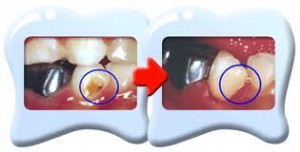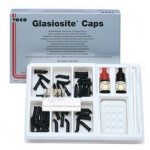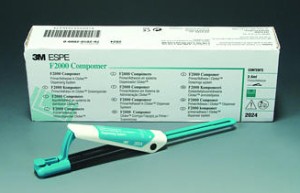Compomers†are recently introduced products marketed as a new class of dental materials. These materials are said to provide the combined benefits of composites (the “comp†in their name) and glass ionomers (“omerâ€). Based on a critical review of the literature, the author argues that “compomers†do not represent a new class of dental materials but are merely a marketing name given to a dental composite.

Tooth restored using compomer
Shortly after the introduction of RMGICs, “compomers†were introduced to the market. They were marketed as a new class of dental materials that would provide the combined benefits of composites (the “comp†in their name) and glass ionomers (“omerâ€). These materials have two main constituents: dimethacrylate monomer(s) with two carboxylic groups present in their structure, and filler that is similar to the ion-leachable glass present in GICs. The ratio of carboxylic groups to backbone carbon atoms is approximately 1:8. There is no water in the composition of these materials, and the ion-leachable glass is partially silanized to ensure some bonding with the matrix. These materials set via a free radical polymerization reaction, do not have the ability to bond to hard tooth tissues, and have significantly lower levels of fluoride release than GICs. Although low, the level of fluoride release has been reported to last at least 300 days. The delayed (post-cure and post-water-sorption) acid-base reaction between sparse carboxylic groups and areas of filler not contaminated by the silane coupling agents is speculative and is probably insignificant to the overall properties of these materials.
 Based on their structure and properties, these materials belong to the class of dental composites. Often, they have been erroneously referred to as “hybrid glass ionomersâ€,“light-cured GICs†or “resin-modified glass ionomers†along with the “genuine†resin-modified GICs. The proposed nomenclature for these materials as polyacid-modified composite resins,a nomenclature that is widely used in the literature, may over-emphasize a structural characteristic of no or little consequence. Considering the low volume fraction filler and the incomplete silanization of the filler, it could be postulated that they are inferior composites. Both in vitro and in vivo investigations have confirmed this expectation. Lower flexural modulus of elasticity,compressive strength, flexural strength, fracture toughness and hardness, along with significantly higher wear rates compared to clinically proven hybrid composites, have been reported for these materials. Their clinical performance received mixed reviews in in vivo clinical trials. With the exception of concerns about the release of HEMA from these materials, no other biocompatibility issues have been associated with their usage.Their applicability as orthodontic adhesives, amalgam bonding systems and veterinary restorative materials has also been reported.
Based on their structure and properties, these materials belong to the class of dental composites. Often, they have been erroneously referred to as “hybrid glass ionomersâ€,“light-cured GICs†or “resin-modified glass ionomers†along with the “genuine†resin-modified GICs. The proposed nomenclature for these materials as polyacid-modified composite resins,a nomenclature that is widely used in the literature, may over-emphasize a structural characteristic of no or little consequence. Considering the low volume fraction filler and the incomplete silanization of the filler, it could be postulated that they are inferior composites. Both in vitro and in vivo investigations have confirmed this expectation. Lower flexural modulus of elasticity,compressive strength, flexural strength, fracture toughness and hardness, along with significantly higher wear rates compared to clinically proven hybrid composites, have been reported for these materials. Their clinical performance received mixed reviews in in vivo clinical trials. With the exception of concerns about the release of HEMA from these materials, no other biocompatibility issues have been associated with their usage.Their applicability as orthodontic adhesives, amalgam bonding systems and veterinary restorative materials has also been reported.
Constant re-formulations of these types of materials may eventually lead to them being comparable or even superior to existing composites, but, as long as they do not set via an acid-base reaction and do not bond to hard-tooth tissues, they cannot and should not be classified with GICs. They are, after all, just another dental composite.
A distinctive feature of compomers is that, following the initial polymerization reaction, they take up small amounts of moisture in situ, and this triggers an acid–base reaction between the reactive glass filler and the acid groups of the functional monomer. Among other features, this process causes fluoride to be released from the glass filler to the matrix, from where it can readily be released into the mouth, and act as an anticariogenic agent. Polymerization is associated with contraction and the development of measurable stresses, and itmay be that the sorption ofwater plays some part in reducing these stresses in vivo.
 The role of the reactive glass in the water uptake process has been considered in one report. A conventional composite resin formulation was used as the matrix phase, with filler being either an unreactive glass, Raysorb T-4000, or the ionomer glass G338, whose composition and properties have been described extensively. In each case, the glass was used both with and without a coating of silane coupling agent (_-methacryloxy propyl trimethoxysilane).
The role of the reactive glass in the water uptake process has been considered in one report. A conventional composite resin formulation was used as the matrix phase, with filler being either an unreactive glass, Raysorb T-4000, or the ionomer glass G338, whose composition and properties have been described extensively. In each case, the glass was used both with and without a coating of silane coupling agent (_-methacryloxy propyl trimethoxysilane).
Dental practitioners should have a good understanding of basic dental materials science principles to enable them to critically assess the plethora of new materials that are constantly being introduced and aggressively marketed. By knowing the structure of a material, practitioners can predict its properties and assess its suitability for particular applications. It is important, therefore, that the classification and the nomenclature of dental materials be based on their structure to maximize the conveyance of relevant structural information. The concept of a continuum that encompasses glass-polyalkenoates, resin-modified glass-polyalkenoates and composites (including “compomersâ€) could only exacerbate the existing confusion and misunderstanding about these materials.
It is also advisable for practitioners to request long-term in vitro and in vivo independently acquired evidence of the performance of a material before deciding to use it. Unfortunately, many of these materials have market lives shorter than the time required to adequately assess their performance. Avoiding such short-lived materials may well be beneficial for both practitioners and patients.
good